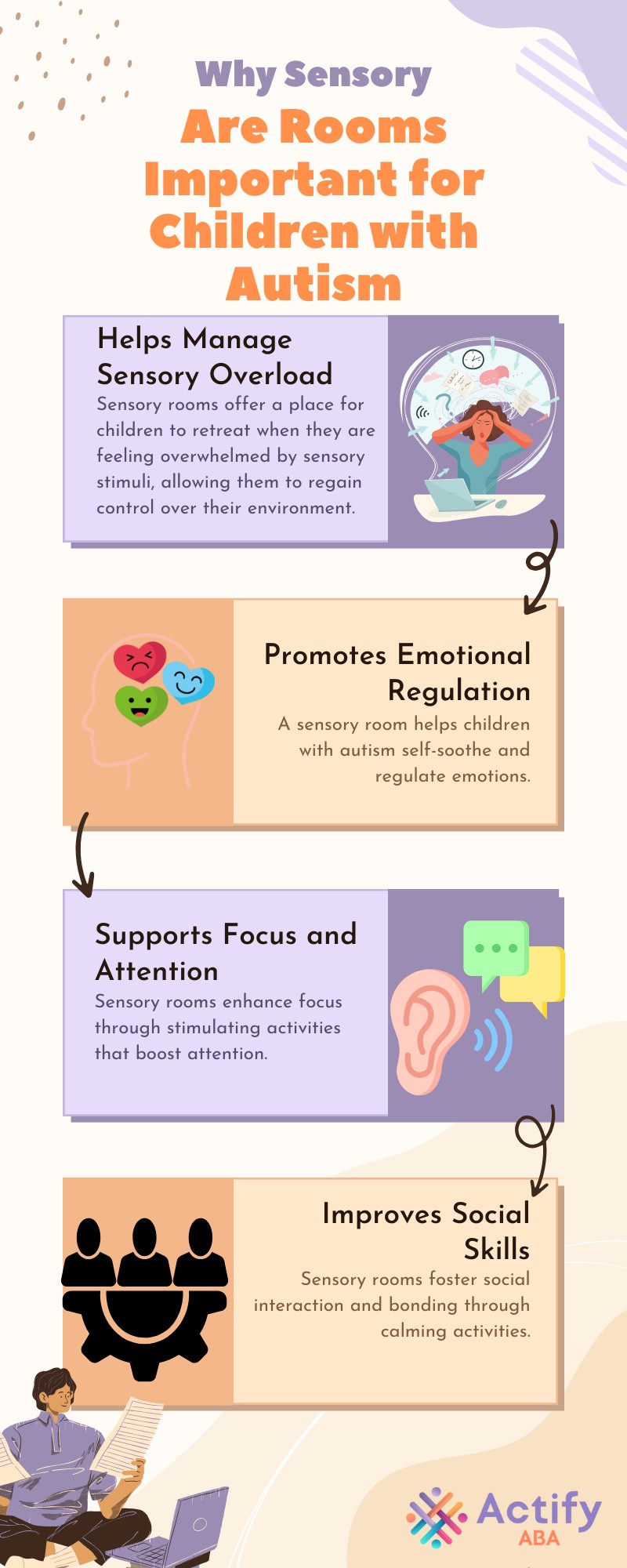
Key Points:
- Sensory rooms can help children with autism regulate sensory input and improve focus, reducing anxiety.
- A sensory room autism environment should include various sensory tools like lighting, textures, and sounds.
- Designing a sensory room at home or school requires thoughtful consideration of the child’s needs and preferences.
Creating a sensory room for autism can be a life-changing strategy for children who need a calming environment to manage sensory overload. For many individuals on the autism spectrum, sensory processing can be a major challenge. In fact, up to 90% of individuals with autism experience some form of sensory processing dysfunction.
Bright lights, loud noises, or even the feel of certain textures can trigger stress or anxiety. A sensory room provides a safe, controlled space where children can self-regulate and engage with sensory stimuli that soothe them.
Sensory rooms are often used in schools, therapy centers, and homes to create an area where children can retreat to when feeling overwhelmed. These spaces promote sensory regulation by offering a variety of stimuli that engage different senses—sight, touch, sound, and sometimes smell or taste. The goal is not just to calm but to help children with autism better process sensory information in a way that supports their emotional and physical well-being.
What Is a Sensory Room for Autism?
A sensory room autism environment is a designated space designed to help children with autism manage and regulate their sensory input. These rooms are often equipped with various tools that allow a child to engage with sensory stimuli in a way that is calming or stimulating, depending on their individual needs.
The key components of a sensory room typically include a mix of visual, tactile, auditory, and sometimes olfactory elements. These elements should be chosen to suit the individual needs of the child, as sensory processing varies from person to person.

Sensory Room Ideas for Autism
Designing a sensory room that meets the needs of a child with autism requires careful thought and consideration. There are a variety of sensory elements that can be included, each targeting different aspects of sensory processing. Below are some sensory room ideas for autism to help you create the right environment:
1. Lighting
Lighting is a crucial aspect of any sensory room. For children with autism, harsh fluorescent lights or bright overhead lighting can be overwhelming. Soft, calming lighting is often the best option. Consider using:
- Color-changing LED lights: These can create a calming atmosphere by allowing the child to adjust the color of the room’s lighting.
- Fiber optic lights: These lights can be visually soothing and provide a gentle, flowing effect.
- Bubble tubes: These often come with changing lights and can be mesmerizing and relaxing.
2. Tactile Sensory Items
Textures can be either soothing or stimulating, depending on the child’s preference. Including tactile sensory items in the room can help children explore different textures and identify what feels comforting. Consider incorporating:
- Soft fabrics: Pillows, blankets, and beanbags made of soft materials provide comfort and can be great for sensory seekers.
- Textured wall panels: Some children may enjoy touching textured surfaces like rubber, velvet, or spongy materials.
- Sensory mats: These mats can have different textures (bumpy, smooth, soft) to walk on or feel with hands and feet.
3. Sound and Music
Auditory input can be a significant concern for children with autism, as they may be hypersensitive to sounds. It’s essential to include calming or white noise elements in a sensory room. Consider using:
- Sound machines: Devices that play white noise or nature sounds (like rain or ocean waves) can help drown out overwhelming sounds.
- Soft music: Music with slow tempos or lullabies can be very relaxing for children who respond positively to sound.
- Noise-canceling headphones: These can help block out unwanted noises and provide a quiet space for those who need less auditory input.
4. Movement and Vestibular Input
Some children with autism benefit from movement, which helps them self-regulate and reduce anxiety. Consider including:
- Swinging chairs or hammock swings: Gentle, rocking movements can be very calming for children.
- Balance boards or balls: These can engage the child’s sense of balance, offering soothing or stimulating experiences.
- Treadmills or mini trampolines: Movement exercises can help children release pent-up energy in a controlled way.
5. Aromatherapy
Smell is another powerful sense that can be calming or energizing, depending on the child’s preferences. Some parents choose to incorporate aromatherapy into the sensory room with essential oils like lavender for relaxation. However, it’s essential to be cautious with smells, as some children with autism may have strong aversions to certain scents.

Tips for Setting Up a Sensory Room for Autism
While it’s important to include various sensory elements in a room, the overall environment should remain adaptable to the individual needs of the child. Here are some tips for creating a sensory room that works for your child:
1. Personalization
Each child with autism has unique sensory preferences. Customize the room based on your child’s preferences, sensitivities, and responses to different stimuli. What works for one child may not work for another.
2. Safety First
Make sure that all equipment and materials in the room are safe and appropriate for the child’s age and developmental stage. Avoid items that may pose a choking hazard or are sharp.
3. Calming Colors and Designs
Choose calming colors, such as soft blues, greens, or pastels, for the room. Bright or bold colors can overstimulate children with sensory sensitivities.
4. Set Boundaries
Establish clear rules for the sensory room. For example, explain that the room is a safe space where the child can go when feeling overwhelmed or needing a break from social interactions.
5. Use a Timer
Some children with autism may have difficulty gauging time. Set a timer for breaks so the child can get used to the idea of managing their time in the sensory room.
Sensory Rooms in Schools and the Role of ABA Therapy
Sensory rooms in schools are becoming increasingly popular as a way to support students, especially those with autism or sensory processing challenges. These specially designed spaces provide a calming environment where students can take a break, regulate their emotions, and manage sensory overload.
Sensory rooms often go hand in hand with Applied Behavior Analysis (ABA) therapy, which can be used to further support students in learning how to manage their behaviors and emotions in a structured way.
Here’s why sensory rooms and ABA therapy together are so effective:
1. Calming and Regulating
Sensory rooms offer soothing lights, textures, and sounds that help students relax, while ABA therapy can teach them to recognize when they need a sensory break and how to self-regulate.
2. Targeted Behavioral Goals
ABA therapy focuses on reinforcing positive behaviors and reducing unwanted behaviors. A sensory room can be part of an overall plan where students practice self-regulation strategies taught in ABA sessions.
3. Improved Focus
After spending time in the sensory room, students can return to their classroom more focused and ready to learn, which is reinforced through ABA techniques that reward appropriate behaviors.
4. Emotional Support
Sensory rooms offer a safe space for emotional regulation, while ABA therapy helps students develop the skills to manage stress, anxiety, and other emotional challenges.
ABA Therapy in Maryland – Supporting Autism Development
At Actify, we offer ABA therapy in Maryland to help children with autism thrive. Our therapy services focus on creating tailored strategies that help children learn essential life skills, improve communication, and manage sensory challenges. ABA therapy is a research-based approach that can be incredibly effective in helping children with autism reach their full potential.
If you are looking for ABA therapy in Maryland, Actify offers professional, compassionate care to support your child’s development. Contact us today to learn how our personalized therapy programs can make a difference in your child’s life.
